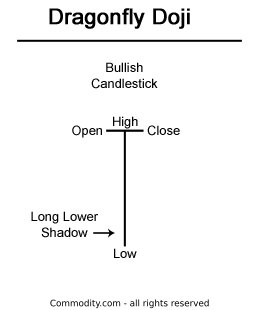A Doji where the open and close price are at the high of the day. Like other Doji days, this one normally appears at market turning points.
The Dragonfly Doji is typically interpreted as a bullish reversal candlestick pattern that mainly occurs at the bottom of downtrends.

The Dragonfly Doji is created when the open, high, and close are the same or about the same price (Where the open, high, and close are exactly the same price is quite rare). The most important part of the Dragonfly Doji is the long lower shadow.
The long lower shadow implies that the market tested to find where demand was located and found it. Bears were able to press prices downward, but an area of support was found at the low of the day and buying pressure was able to push prices back up to the opening price. Thus, the bearish advance downward was entirely rejected by the bulls.
Dragonfly Doji Candlestick Chart
Example The chart below of the mini-Dow Futures contract illustrates a Dragonfly Doji occuring at the bottom of a downtrend:

In the chart above of the mini-Dow, the market began the day testing to find where demand would enter the market. The mini-Dow eventually found support at the low of the day, so much support and subsequent buying pressure, that prices were able to close the day approximately where they started the day.
The Dragonfly Doji is a helpful Candlestick pattern to help traders visually see where support and demand is was located. After a downtrend, the Dragonfly Doji can signal to traders that the downtrend could be over and that short positions could potentially be covered. Other indicators should be used in conjunction with the Dragonfly Doji pattern to determine potential buy signals, for example, a break of a downward trendline.
The bearish version of the Dragonfly Doji is the Gravestone Doji (see: Gravestone Doji).